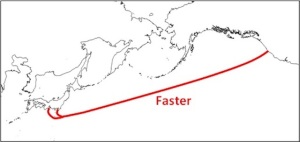Quote of the Day
Conformity is the jailer of freedom and the enemy of growth.
- John F. Kennedy
In the past decade, we have seen a massive growth in the need for fast bandwidth. Modern businesses have higher bandwidth requirements due to the amount of data they use and consume so they are having to discover new technology, like SD-WAN, that can meet these requirements without spending too much money. And now, there have been some very interesting developments with some of the biggest companies in the world addressing these issues and investing in interesting ways to combat it. I was just reading an article on the FASTER project, which is a submarine cable project that will deliver an initial information capacity of 60 Terabits Per Second (Tbps) between the US and Asia. This is substantially more than the 4 Tbps we typically see today in these systems (example). It does this by extensive use of Wavelength-Division Multiplexing (WDM), with each wavelength carrying 100 Gigabits per second (Gbps) over a six-pair cable. The overall design capacity of this system is given by the following calculation:
| Eq. 1 |
The cable will run a distance of 10,000 km between Japan and the US (Figure 1).
I have worked on submarine cables (late 1980s) and it is very interesting technology. If you are interested in some general information on submarine cables, this article is good. The Wikipedia maintains a list of submarine cables and you can see that there are a lot of them. If you want to get some details on a typical submarine fiber cable system, see this Wikipedia article.
There are two key technologies involved here:
- Wavelength Division Multiplexing
The ability of fiber to carry multiple wavelengths at the same time makes this an obvious approach for increasing bandwidth. Unfortunately, it generally requires precise temperature control of the lasers to ensure that their wavelengths stay in their assigned "lanes".
- Coherent Communications
The vast majority of the deployed optical systems today are Non-Return-to-Zero (NRZ) encoded ? a "1" equals laser on and a "0" equals laser off. I am now seeing more and more use of coherent optical transports. See this article for a reasonable briefing on the topic. If you want to see an example of the hardware, check out this web site (a shout-out to my friend Mike Wirtz, who works there).
The combined use of WDM and coherent communications can provide an enormous increase in the bandwidth of a communication system.
I currently work on Fiber-To-The-Home (FTTH) systems (GPON, EPON, and Active Ethernet) that are delivering 1 Gbps to homes. As these systems become more widely deployed, the Internet backbone will need a major bandwidth upgrade to support aggregating the bandwidth increases occurring at the edges of the network. And the pressure on the Internet backbone is only going to increase. For example, while current GPON systems support 2.488 Gbps downstream and 1.244 Gbps upstream, NGPON2 is coming and will provide 16 channels of 10 Gbps bandwidth. This is on residential and business fiber lines!
Unfortunately, I still struggle at my home with the very limited service provided by a cable network. Someday I hope to enjoy for myself the service that I work on developing every day.


Pingback: Submarine Fiber-Optic Cable Trivia | Math Encounters Blog